-
 Bitcoin
Bitcoin $84,603.0303
1.65% -
 Ethereum
Ethereum $1,628.2638
2.58% -
 Tether USDt
Tether USDt $0.9997
0.00% -
 XRP
XRP $2.1442
1.55% -
 BNB
BNB $586.1953
0.71% -
 Solana
Solana $129.6970
2.29% -
 USDC
USDC $0.9998
-0.02% -
 TRON
TRON $0.2518
-0.50% -
 Dogecoin
Dogecoin $0.1586
-2.40% -
 Cardano
Cardano $0.6343
-0.80% -
 UNUS SED LEO
UNUS SED LEO $9.3746
-0.17% -
 Avalanche
Avalanche $20.1994
3.26% -
 Chainlink
Chainlink $12.7466
0.99% -
 Stellar
Stellar $0.2381
-0.55% -
 Sui
Sui $2.1883
-1.27% -
 Shiba Inu
Shiba Inu $0.0...01199
-0.40% -
 Toncoin
Toncoin $2.8442
-1.19% -
 Hedera
Hedera $0.1656
0.38% -
 Bitcoin Cash
Bitcoin Cash $324.3031
-5.45% -
 Polkadot
Polkadot $3.7104
0.32% -
 Litecoin
Litecoin $76.9539
-0.90% -
 Dai
Dai $0.9999
-0.01% -
 Hyperliquid
Hyperliquid $15.5187
1.91% -
 Bitget Token
Bitget Token $4.2785
-0.04% -
 Pi
Pi $0.7383
-0.07% -
 Ethena USDe
Ethena USDe $0.9989
0.00% -
 Monero
Monero $215.8052
6.03% -
 Uniswap
Uniswap $5.3859
0.83% -
 OKB
OKB $52.8701
-0.49% -
 Pepe
Pepe $0.0...07327
0.90%
What is the core difference between a spot Bitcoin ETF and a futures Bitcoin ETF?
Spot Bitcoin ETFs hold actual Bitcoin, directly tracking its price, while futures Bitcoin ETFs invest in futures contracts, which may not align perfectly with Bitcoin's spot price.
Apr 10, 2025 at 06:29 am
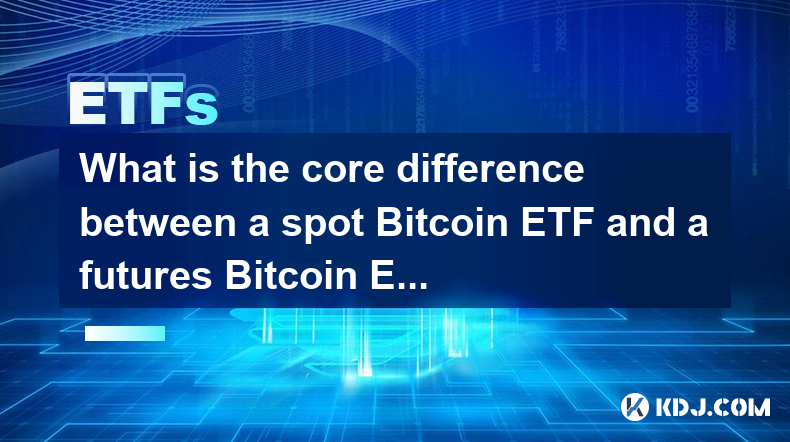
The cryptocurrency market has seen significant growth and innovation, leading to the development of various financial products that allow investors to gain exposure to Bitcoin without directly owning the cryptocurrency. Two such products are the spot Bitcoin ETF and the futures Bitcoin ETF. Understanding the core differences between these two types of ETFs is crucial for investors looking to navigate the crypto investment landscape effectively.
Definition of a Spot Bitcoin ETF
A spot Bitcoin ETF is an exchange-traded fund that directly tracks the price of Bitcoin. This type of ETF holds actual Bitcoin in its portfolio, meaning that the value of the ETF is directly tied to the current market price of Bitcoin. When you invest in a spot Bitcoin ETF, you are essentially investing in Bitcoin itself, but through a regulated financial product that can be traded on traditional stock exchanges.
Definition of a Futures Bitcoin ETF
In contrast, a futures Bitcoin ETF does not hold actual Bitcoin. Instead, it invests in Bitcoin futures contracts, which are agreements to buy or sell Bitcoin at a future date at a predetermined price. These futures contracts are traded on regulated futures exchanges, such as the Chicago Mercantile Exchange (CME). The value of a futures Bitcoin ETF is based on the prices of these futures contracts, which can differ from the spot price of Bitcoin due to factors such as market sentiment and the time until the futures contract expires.
Key Differences in Investment Mechanism
The primary difference between a spot Bitcoin ETF and a futures Bitcoin ETF lies in their investment mechanisms. A spot Bitcoin ETF directly holds Bitcoin, providing a more straightforward exposure to the cryptocurrency's price movements. On the other hand, a futures Bitcoin ETF relies on futures contracts, which can introduce additional layers of complexity and risk due to the nature of futures trading.
Impact on Price Tracking
Another significant difference is how these ETFs track the price of Bitcoin. A spot Bitcoin ETF aims to mirror the real-time price of Bitcoin, offering investors a direct correlation to the cryptocurrency's market value. Conversely, a futures Bitcoin ETF tracks the price of Bitcoin futures, which may not always align perfectly with the spot price of Bitcoin. This discrepancy can lead to tracking errors, where the ETF's performance deviates from the actual price of Bitcoin.
Regulatory Considerations
Regulatory environments also play a crucial role in distinguishing between these two types of ETFs. Spot Bitcoin ETFs have faced more regulatory hurdles in many jurisdictions, as they involve direct ownership of a cryptocurrency, which is still a relatively new and volatile asset class. In contrast, futures Bitcoin ETFs have been more readily approved by regulators, as they are based on futures contracts, which are more familiar to traditional financial markets.
Risk and Volatility
The risk and volatility associated with these ETFs can differ significantly. Spot Bitcoin ETFs are directly exposed to the price volatility of Bitcoin, which can be substantial. However, they do not carry the additional risks associated with futures contracts, such as the need to roll over contracts and the potential for contango or backwardation. Futures Bitcoin ETFs, on the other hand, are subject to the risks inherent in futures trading, including the potential for significant losses if the futures market moves against the ETF's positions.
Liquidity and Accessibility
Liquidity and accessibility are other factors to consider. Spot Bitcoin ETFs can offer high liquidity, as they are traded on major stock exchanges and can be bought and sold like any other stock. This makes them accessible to a wide range of investors, including those who may not have direct access to cryptocurrency exchanges. Futures Bitcoin ETFs also offer liquidity, but their performance can be influenced by the liquidity of the futures market, which can sometimes be less robust than the spot market.
Tax Implications
Tax implications can vary between the two types of ETFs. Spot Bitcoin ETFs are typically treated as investments in the underlying asset, meaning that gains or losses are subject to capital gains tax. Futures Bitcoin ETFs, however, may be subject to different tax treatments, as they are considered derivatives. Investors should consult with a tax professional to understand the specific tax implications of investing in either type of ETF.
Suitability for Different Investors
The suitability of these ETFs for different types of investors can also vary. Spot Bitcoin ETFs may be more suitable for investors who want direct exposure to Bitcoin's price movements and are comfortable with the volatility of the cryptocurrency market. Futures Bitcoin ETFs might appeal to investors who are more familiar with traditional financial markets and are looking for a way to gain exposure to Bitcoin without directly owning the cryptocurrency.
Frequently Asked Questions
Q: Can I convert a spot Bitcoin ETF to a futures Bitcoin ETF?
A: No, you cannot directly convert one type of ETF to another. If you wish to switch from a spot Bitcoin ETF to a futures Bitcoin ETF, you would need to sell your holdings in the spot ETF and then purchase shares in the futures ETF. This process involves transaction costs and potential tax implications, so it should be done carefully.
Q: Are there any ETFs that combine both spot and futures Bitcoin exposure?
A: As of now, there are no ETFs that directly combine both spot and futures Bitcoin exposure. However, some investment products may offer a mix of different assets, including both spot and futures contracts, but these are not classified as ETFs.
Q: How do I choose between a spot Bitcoin ETF and a futures Bitcoin ETF?
A: Choosing between a spot Bitcoin ETF and a futures Bitcoin ETF depends on your investment goals, risk tolerance, and familiarity with the cryptocurrency and futures markets. If you want direct exposure to Bitcoin's price and are comfortable with its volatility, a spot Bitcoin ETF might be more suitable. If you prefer a more traditional investment approach and are familiar with futures trading, a futures Bitcoin ETF could be a better fit.
Q: Can I use a spot Bitcoin ETF to hedge against my Bitcoin holdings?
A: Yes, you can use a spot Bitcoin ETF to hedge against your Bitcoin holdings. By taking a position in a spot Bitcoin ETF that is opposite to your direct Bitcoin holdings, you can potentially mitigate some of the risks associated with Bitcoin's price volatility. However, this strategy requires careful management and understanding of the ETF's performance relative to the spot price of Bitcoin.
Disclaimer:info@kdj.com
The information provided is not trading advice. kdj.com does not assume any responsibility for any investments made based on the information provided in this article. Cryptocurrencies are highly volatile and it is highly recommended that you invest with caution after thorough research!
If you believe that the content used on this website infringes your copyright, please contact us immediately (info@kdj.com) and we will delete it promptly.
- Vaulta Emerges from Its Past with a Renewed Focus on Practical Finance and Compliance-First Blockchain Infrastructure
- 2025-04-15 04:50:13
- Render Network (RNDR), SEI and Bittensor (TAO) lead crypto AI sector despite 5% daily drop
- 2025-04-15 04:50:13
- HYPE is showing early signs of a bullish reversal, with a potential inverse head and shoulders pattern forming
- 2025-04-15 04:45:13
- BlockDAG (BDAG) Captures Developer Attention with Complete Smart Contract Features and Growing $214M Presale
- 2025-04-15 04:45:13
- title: RWA-Focused Crypto Project MANTRA (OM) Loses $5.431B of Market Cap in Overnight Collapse of Its Native Token
- 2025-04-15 04:40:15
- Trump's Tariffs Just Supercharged Bitcoin – Here's What's Coming
- 2025-04-15 04:40:15
Related knowledge
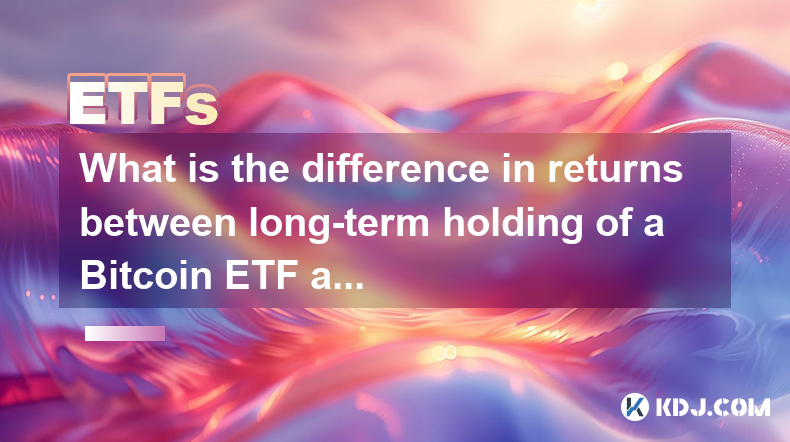
What is the difference in returns between long-term holding of a Bitcoin ETF and holding Bitcoin directly?
Apr 09,2025 at 04:15am
When considering the difference in returns between long-term holding of a Bitcoin ETF and holding Bitcoin directly, it's essential to understand the nuances and factors that affect each investment option. Both approaches have their unique advantages and potential drawbacks, which can significantly impact the overall returns over time. Understanding Bitc...
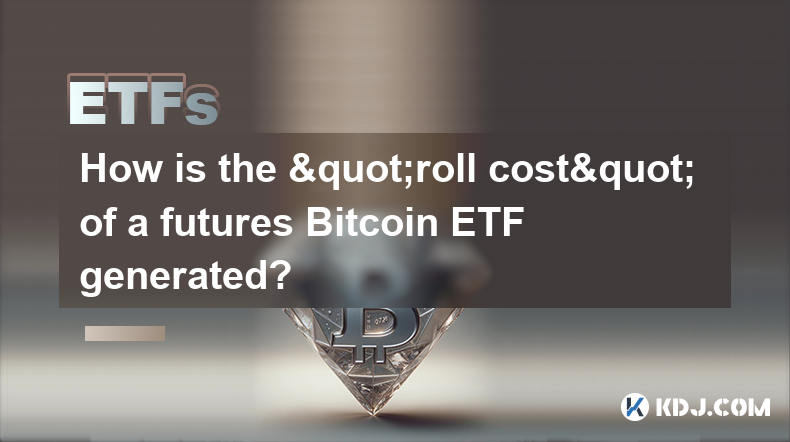
How is the "roll cost" of a futures Bitcoin ETF generated?
Apr 08,2025 at 01:22pm
The 'roll cost' of a futures Bitcoin ETF is a critical concept for investors to understand, as it directly impacts the performance of the ETF. In this article, we will delve into the mechanics of how the roll cost is generated, exploring the underlying processes and factors that contribute to this cost. Understanding Futures ContractsFutures contracts a...
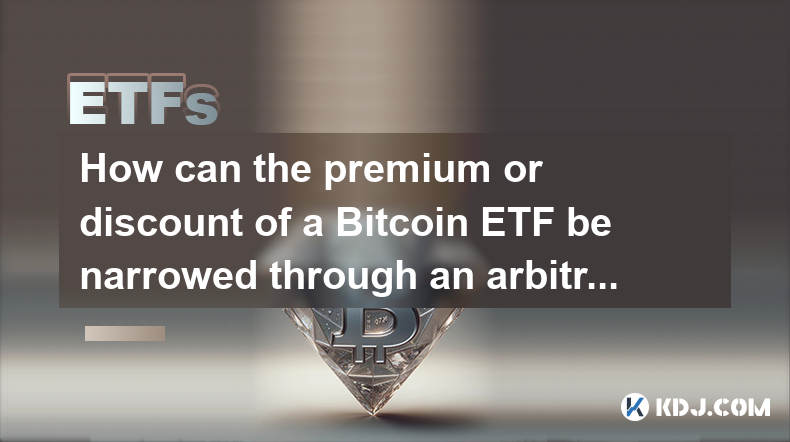
How can the premium or discount of a Bitcoin ETF be narrowed through an arbitrage mechanism?
Apr 09,2025 at 12:07am
Arbitrage mechanisms play a crucial role in narrowing the premium or discount of a Bitcoin Exchange Traded Fund (ETF). Understanding how these mechanisms work can provide valuable insights into the dynamics of Bitcoin ETFs and their relationship with the underlying asset. This article will delve into the specifics of how arbitrage can be used to align t...

What factors affect the bid-ask spread of a Bitcoin ETF?
Apr 08,2025 at 08:50pm
The bid-ask spread of a Bitcoin Exchange Traded Fund (ETF) is a critical metric that investors and traders closely monitor. It represents the difference between the highest price a buyer is willing to pay (bid) and the lowest price a seller is willing to accept (ask). Several factors influence this spread, and understanding them can help investors make ...
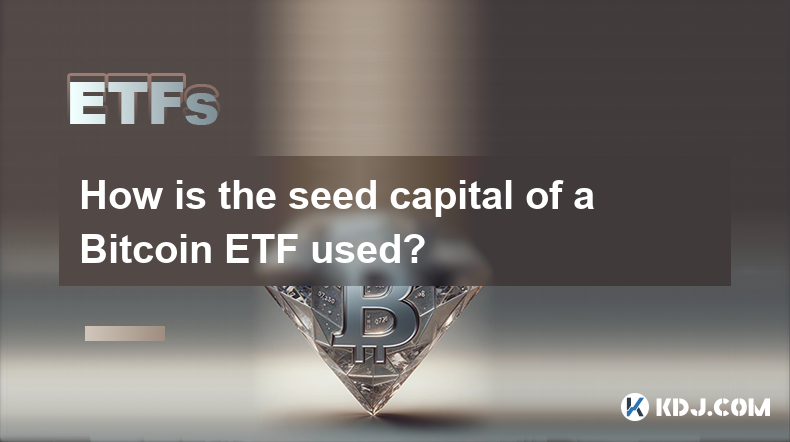
How is the seed capital of a Bitcoin ETF used?
Apr 10,2025 at 02:15pm
The seed capital of a Bitcoin ETF plays a crucial role in the establishment and operation of the fund. This initial investment is used to create the fund's underlying assets, manage operational costs, and ensure the ETF can start trading on an exchange. Understanding how this seed capital is utilized provides insight into the mechanics of Bitcoin ETFs a...
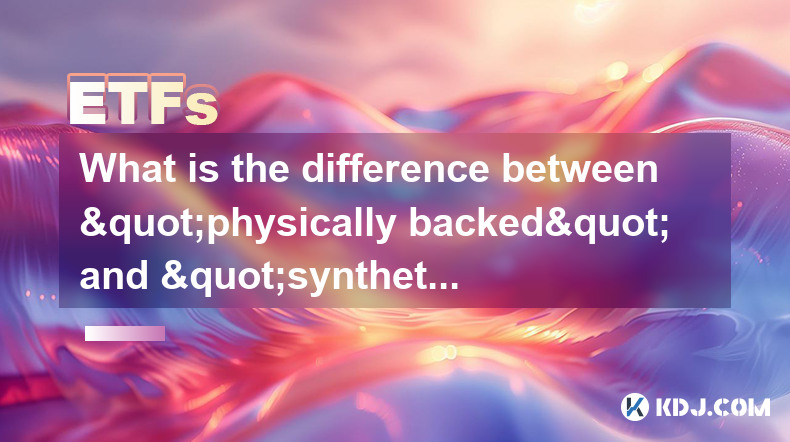
What is the difference between "physically backed" and "synthetic" Bitcoin ETFs in terms of holding assets?
Apr 10,2025 at 04:56pm
Bitcoin Exchange Traded Funds (ETFs) have become a popular way for investors to gain exposure to the cryptocurrency market without directly owning the underlying asset. There are two primary types of Bitcoin ETFs: physically backed and synthetic. Understanding the differences between these two types, particularly in terms of how they hold assets, is cru...

What is the difference in returns between long-term holding of a Bitcoin ETF and holding Bitcoin directly?
Apr 09,2025 at 04:15am
When considering the difference in returns between long-term holding of a Bitcoin ETF and holding Bitcoin directly, it's essential to understand the nuances and factors that affect each investment option. Both approaches have their unique advantages and potential drawbacks, which can significantly impact the overall returns over time. Understanding Bitc...

How is the "roll cost" of a futures Bitcoin ETF generated?
Apr 08,2025 at 01:22pm
The 'roll cost' of a futures Bitcoin ETF is a critical concept for investors to understand, as it directly impacts the performance of the ETF. In this article, we will delve into the mechanics of how the roll cost is generated, exploring the underlying processes and factors that contribute to this cost. Understanding Futures ContractsFutures contracts a...

How can the premium or discount of a Bitcoin ETF be narrowed through an arbitrage mechanism?
Apr 09,2025 at 12:07am
Arbitrage mechanisms play a crucial role in narrowing the premium or discount of a Bitcoin Exchange Traded Fund (ETF). Understanding how these mechanisms work can provide valuable insights into the dynamics of Bitcoin ETFs and their relationship with the underlying asset. This article will delve into the specifics of how arbitrage can be used to align t...

What factors affect the bid-ask spread of a Bitcoin ETF?
Apr 08,2025 at 08:50pm
The bid-ask spread of a Bitcoin Exchange Traded Fund (ETF) is a critical metric that investors and traders closely monitor. It represents the difference between the highest price a buyer is willing to pay (bid) and the lowest price a seller is willing to accept (ask). Several factors influence this spread, and understanding them can help investors make ...

How is the seed capital of a Bitcoin ETF used?
Apr 10,2025 at 02:15pm
The seed capital of a Bitcoin ETF plays a crucial role in the establishment and operation of the fund. This initial investment is used to create the fund's underlying assets, manage operational costs, and ensure the ETF can start trading on an exchange. Understanding how this seed capital is utilized provides insight into the mechanics of Bitcoin ETFs a...

What is the difference between "physically backed" and "synthetic" Bitcoin ETFs in terms of holding assets?
Apr 10,2025 at 04:56pm
Bitcoin Exchange Traded Funds (ETFs) have become a popular way for investors to gain exposure to the cryptocurrency market without directly owning the underlying asset. There are two primary types of Bitcoin ETFs: physically backed and synthetic. Understanding the differences between these two types, particularly in terms of how they hold assets, is cru...
See all articles























































































